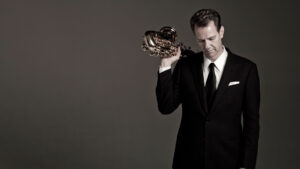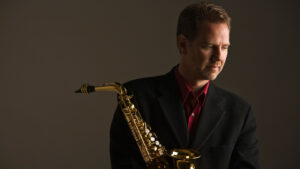How is this for a challenge? You have the responsibility of giving the world premiere of a new concerto by Academy Award-winning composer John Corigliano (The Red Violin). You are the person for whom it was written and you learn that the 30-minute piece calls for you use three different kinds of saxophones – one for each movement. To add a heightened degree of difficulty the last part of the concerto requires a quick switch back to the sax used in the first movement. Such is the task that acclaimed musician Timothy McAllister has this weekend.
Beginning today McAllister gives the first three performances of Corigliano’s Triathlon with the San Francisco Symphony. The concerto, commissioned by the SF Symphony, will also be performed Friday and Saturday.
McAllister is no stranger to world premieres. He’s an ardent supporter of new music and has given performances of over 200 new works, most notably John Adams’ Saxophone Concerto in 2013. He’s also a founding member of PRISM Quartet, an award-winning saxophone chamber quartet that focuses on newer music.

Triathlon, however, is unlike any other piece McAllister has performed.
“He’s one of the greatest pros in history and it’s the thrill of my life to work with him,” he said recently during our Zoom conversation. “His real experience with the instrument’s capabilities came from some one-on-one sessions where I flew to his condo in New York and literally brought the instruments to him. He would even show me some drafts, some things, some ideas he had in mind.”
The main idea Corigliano had in mind, which gives the pieces its title, is the use of a different saxophone for each movement: a soprano saxophone for the first; an alto saxophone for the second and the baritone sax for the final movement. So daunting is Triathlon that in many ways, McAllister revealed, he’s training in a way an athlete might for an actual race.
“There’s conditioning required to be able to make those switches and and feel like I can really immediately command the challenges of each of the movements. A Broadway musician is used to switching three or four instruments over the course of a show. But they’re not being asked to tackle the kinds of things we’re talking about in this concerto. For me right now I’m in the habit of doing these kind of global runs where I’m trying to really pace out my energy and really assess whether I have the right set up, right kind of reach, strength or whatever that’s going to allow me to just pick up the next instrument and be able to produce exactly what I want. And I think the greatest challenge.”
He goes to describe how that last switch back in the final moments of the concerto is going to be a true test of his skills.
“At the end of the end of the entire concerto, going right back to the soprano in this massive callback to the first movement, he’s got me immediately playing like really high. And we talked about it a lot and he knows it’s hard. But he really felt that it was crucial to tying the whole piece together.”
Corigliano even asked McAllister if what he was creating was even possible to do.
“We’ve had some back and forth about some passages in his piece where he’s saying, ‘Is that too hard? Is this just unrealistic?’ But my response is what is your vision for this? If you want it there in that range or you want this fast of a passage, if that’s how you hear it, I’m going to fight like hell to give it to you. I want to be committed to what you want. Right now I’m seven out of ten times. I’ll nail it by concert, I promise you. I’m going to get it ten out of ten times.”
Which means McAllister has to do that one thing every musician has to accept: practice, practice, practice. But no matter how much practicing McAllister can do in advance of performance week, there is one thing he can’t replicate.

“When it comes to just being a saxophone, making it through a 30-minute piece, you start to really address how your breathing; pacing yourself in a practice session so I don’t blow out my chops and it doesn’t ruin the next day. We’ve talked a little bit about the challenges of rehearsing it when I think all of the rehearsals are going to be focused primarily on the Wednesday before the first Thursday matinee. John’s worried for me because there will be such an intense day of rehearsing on that day before and then there’ll be a dress rehearsal and then a concert. I really can’t recreate that for myself. I can’t recreate that game speed, so to speak, right? They talk about that in athletics all the time. You don’t really know how you’re going to respond until you get punched in the mouth by your opponent. And I mean, I hate to feel like that, but I’m going to have to leave it up to how I feel in that moment because the orchestral scenario is going to be another challenge that I can’t recreate for myself until I get there.”
Once he gets through these three performances he embarks on a new work by Tyshawn Sorry. But for right now McAllister feels that Triathlon will join the Adams concerto as a pivotal moment in his career.
“These are going to be the cornerstones of my legacy as a performer and teacher. [I’ve] devoted my life to kind of giving back and then paying it forward and trying to make the state of my instrument better than how I found it. Those two pieces, by those two composers – these are dreams come true.”
To see our full interview with Timothy McAllister please go here.
All photos courtesy of Timothy McAllister














Unbelievable. Thus has yo be one if the most difficult challenges for a musician in history. If anyone can do it, Timothy McAllister can – he is the world’s greatest saxophonist. Bravo.